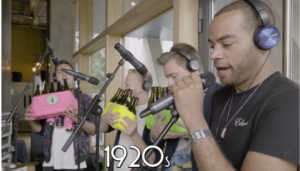What do we mean by closing the glass loop?
When it’s collected properly, glass is entirely and endlessly recyclable, making it an invaluable (and more importantly, sustainable!) resource for producing new forms of packaging without relying on raw materials. Instead of continually making, using and disposing of glass packaging when it’s emptied or broken, in a closed loop, the recycled glass bottles become the most important resource to produce new bottles. This means that the same glass bottle or jar continues to go back into use again and again and again, and is kept in the loop for as long as possible.
By creating new glass packaging with as much recycled glass content as possible, instead of using new raw materials, we can save on natural resources, avoid filling up landfills and cut energy emissions – with endless benefits for the planet.
Glass already ranks as Europe’s most recycled food and beverage packaging material: today, 76% of all glass packaging placed on the EU market is collected for recycling. That’s 3 out of every 4 bottles or jars!
But we know we can do better. To properly close the glass loop, we need to make sure that all the glass containers are properly collected, recycled and processed. That’s why we want to collect and recycle every last bottle, jar and flacon that goes out onto the supermarket shelves, from Aberdeen to Agrigento, and bring it back into the loop.
So here’s five ways you can help ‘close the glass loop,’ no matter where you are.
1. Make sure you’re sorting right.
Got a broken plate, a cracked Pyrex container or tableware glass which has seen better years? Hit pause before you toss it into the bottle bank! Did you know that it can’t be recycled together with regular glass bottles or jars? It may seem like you’re doing the environment a favour by putting it out into the recycling, but in fact it will potentially ruin the entire quality of the recycled batch, making the whole lot a write off! This should be carefully wrapped and disposed of in your regular rubbish collection. Read more on how to raise your recycling game.
2. Get your whole household on board.
It takes 21 days to build a habit. Whether you’re sharing student digs with strangers or running around after toddlers, get the people you live with to pledge to recycle everything for a month. Once it’s part of their routine, they’ll never look back!
3. Rethink your kitchen set up.
Sure, recycling can sometimes seem like yet another chore, but there are ways to make it easier on yourself. Do you have separate containers under the counter to make it easy to separate different types of recycling? Or if you keep your glass recycling on your balcony, maybe it’s time to think about moving it next to your front door so that you can make a trip to the bottle bank part of your weekly routine before it builds up.
4. Better yet, make a bottle bank run part of your exercise regime!
Your local gym might still be closed, but who needs a weights rack when you can make your recycling routine part of your strength training? Start off with wine bottle workouts for all-over body conditioning, and gain upper body strength with each bag dropped off at the bottle bank. For bonus points, why not offer to collect your neighbours’ recycling too?
5. Get educated and speak up.
Do you know what your local area’s recycling rate is, or how many recycling centres can be found in your neighbourhood? It could vary from an incredible 98% glass collection rate in Sweden to an estimated 33% recycling rate in the USA. In fact, some areas have no local recycling infrastructure in place at all, making it hard for people to recycle even if they want to. So why not speak up as a citizen and lobby your local politicians for better glass recycling infrastructure? Even a simple email can be a starting point to make it clear that you want better recycling facilities in your area.
Do you have a brilliant idea for getting recycling rates up which hasn’t been covered here? Let us know – @FriendsofGlass on Twitter, Instagram and Facebook!




